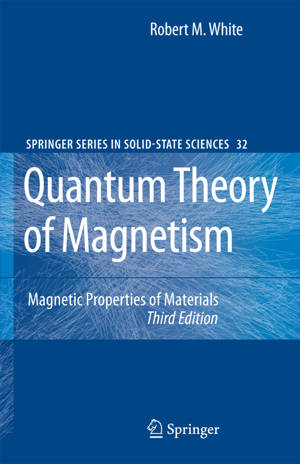
- Afhalen na 1 uur in een winkel met voorraad
- Gratis thuislevering in België vanaf € 30
- Ruim aanbod met 7 miljoen producten
- Afhalen na 1 uur in een winkel met voorraad
- Gratis thuislevering in België vanaf € 30
- Ruim aanbod met 7 miljoen producten
Zoeken
€ 316,45
+ 632 punten
Uitvoering
Omschrijving
"Quantum Theory of Magnetism" is the only book that deals with the phenomenon of magnetism from the point of view of "linear response". That is, how does a magnetic material respond when excited by a magnetic field? That field may be uniform, or spatially varying, static or time dependent. Previous editions have dealt primarily with the magnetic response. This edition incorporates the resistive response of magnetic materials as well. It also includes problems to test the reader's (or student's) comprehension. The rationale for a book on magnetism is as valid today as it was when the first two editions of Quantum Theory of Magnetism were published. Magnetic phenomena continue to be discovered with deep scientific implications and novel applications. Since the Second Edition, for example, Giant Magneto Resistance (GMR) was discovered and the new field of "spintronics" is currently expanding. Not only do these phenomena rely on the concepts presented in this book, but magnetic properties are often an important clue to our understanding of new materials (e.g., high-temperature superconductors). Their magnetic properties, studied by susceptibility measurements, nuclear magnetic resonance, neutron scattering, etc. have provided insight to the superconductivity state.This updated edition offers revised emphasis on some material as a result of recent developments and includes new material, such as an entire chapter on thin film magnetic multilayers. Researchers and students once again have access to an up-to-date classic reference on magnetism, the key characteristic of many modern materials.
Specificaties
Betrokkenen
- Auteur(s):
- Uitgeverij:
Inhoud
- Aantal bladzijden:
- 362
- Taal:
- Engels
- Reeks:
- Reeksnummer:
- nr. 32
Eigenschappen
- Productcode (EAN):
- 9783540651161
- Verschijningsdatum:
- 8/12/2006
- Uitvoering:
- Hardcover
- Formaat:
- Genaaid
- Afmetingen:
- 156 mm x 234 mm
- Gewicht:
- 703 g

Alleen bij Standaard Boekhandel
+ 632 punten op je klantenkaart van Standaard Boekhandel
Beoordelingen
We publiceren alleen reviews die voldoen aan de voorwaarden voor reviews. Bekijk onze voorwaarden voor reviews.











